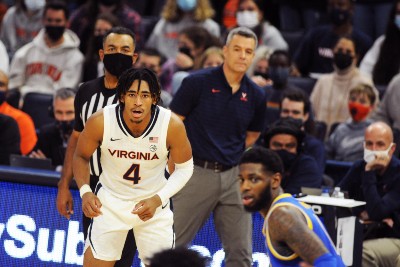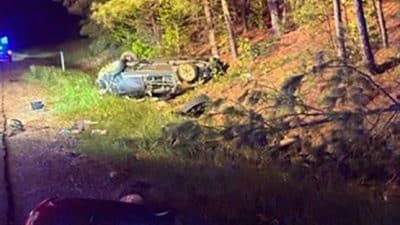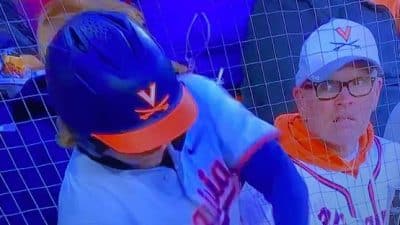
I wasn’t thinking that this year was going to be a rebuilding year until we had Jason Williford on “The Jerry Ratcliffe Show” on the eve of the season, and he kept using the term, “work in progress.”
My thinking was, the additions of transfers Jayden Gardner (East Carolina) and Armaan Franklin (Indiana) would make up for the punch lost to graduation (Jay Huff, Sam Hauser) and the NBA Draft (Trey Murphy III), and that the new group would be better on the defensive end, because they had to be.
I also assumed that we’d see an improved Reece Beekman, who no doubt would have spent the spring and summer working on his jumper, and Kadin Shedrick, assuming he could get through a season healthy for once.
Then throw in talented freshmen Taine Murray and Igor Milicic Jr., and hey, maybe this team could be better, in the end.
I expected growing pains early.
That’s the only thing that has played to expectations to this point.
The 6-4 start itself is maybe only a slight surprise. You had to have figured at least two losses, at Houston and maybe at home to Iowa.
The season-opening loss to Navy, which went on to double-digit losses at Virginia Tech and Louisville immediately after pulling the upset, was not on the radar.
Neither was the loss at JMU, which had trailed D3 EMU at the half a few days before that upset.
Virginia comes in at 58 in the KenPom.com rankings, 101 in the NET, 145 in RPI.
KenPom has the ‘Hoos based on current trends finishing 16-14. BartTorvik.com projects things out at 15-15.
These assume no growth from where the team is now into February and then March.
Which gets us to the question: is there growth for this team on the horizon?
Offense
Gardner (13.9 ppg, 57.4% FG) and Franklin (11.3 ppg, 39.3% FG, 20.4% 3FG) have emerged as the go-to guys, but Franklin has been a major disappointment as a shooter.
That 20.4 percent mark from three stands out. Last year at IU, Franklin was 42.4 percent from behind the arc.
His struggles have made Kihei Clark (10.7 ppg, 42.9% FG, 40.9% 3FG) the team’s deep threat, but Clark is mainly a standstill shooter, and is still being used as the primary initiator at point, which is asking an awful lot of our guy, yet again.
Beekman (6.3 ppg, 32.5% FG, 15.8% 3FG) apparently didn’t work on his jumper in the offseason. He’s just 5-of-34 (14.7%) on two- and three-point jumpers this season.
Disappointing, there.
The Cavaliers are shooting 30.2 percent from three as a team this season, down sharply from the 37.5 percent mark from a year ago.
Gardner is giving UVA more punch in the post, but honestly, he could be used more. The 6’7” power forward is getting 9.4 field goal attempts per game, and surprisingly, just 3.9 free throw attempts per game.
Last year at ECU, Gardner put up 7.4 free throw attempts per game, nearly double his rate this season.
Gardner is averaging a team-best 5.2 shots per game at the rim, which compared to last year’s leader (Huff: 3.9) is a step forward in terms of attacking the paint, but not enough to make up for the awful shooting from deep.
Shedrick (6.9 ppg, 55.8% FG) gets just 4.3 shot attempts per game. The 7-footer does get to the line (3.0 per game), so even with Gardner’s numbers there not being what you expected coming in, we are seeing more activity in general at the line – this year: 16.1 attempts per game, last year: 11.5 attempts per game.
Turnovers are up from last year – from 9.2 per game to 10.2 per game.
Overall efficiency is way down: 105.3 points per 100 possessions, per KenPom, down from 114.7 points per 100 possessions a year ago.
Defense
There have been flashes of brilliance, around bouts of despair.
Navy was 11-of-21 from three in the upset. Houston: 11-of-20, Iowa: 10-of-21, Pitt: 8-of-16.
Overall, opponents are shooting 33.3 percent from deep, which is actually a tick better than the 33.9 percent that last year’s opponents were able to hit.
But threes were key in three of the four losses, and the Pitt near-miss.
The stats also tell us that opponents are getting 9.6 offensive rebounds per game, up from 7.3 per game a year ago.
Cleaning up the defensive boards is a must in the Pack-Line, so there’s obvious room for improvement there.
Overall efficiency is holding steady: 93.4 points per possession this year, 93.3 points per possession last year.
But that’s not good news. Last year’s group was a big step back from recent vintage Tony Bennett Virginia basketball.
Bennett knowingly sacrificed defense for offense to get Hauser, Huff and TM3 on the floor together for 30+ minutes per night.
This year’s group is supposed to be more built around its ability to get stops, and to date, it hasn’t been getting enough of them.
Work in progress
Getting back to Williford on the podcast, the coaching staff knew going in that this team was going to be a work in progress.
So, are we seeing progress?
The near-miss with Pitt, which Gardner pulled out of his arse with five points in the final 11 seconds, and the frustrating, bricklaying loss at JMU, sent us into the break thinking, uh, no.
The offense averaged .973 points per possession over those two losses, and again, it was Pitt and JMU on the other side of the floor.
Twenty-six of the 50 shots from the field in the JMU loss were from three, this from a team that isn’t equipped to beat teams from three.
Bennett and his staff have had time, working around finals week, to tweak the offense, and it will be interesting to see what they do, if anything.
I can say this: this team isn’t just suddenly going to get proficient at hitting jumpers off screens and spot ups, unless Franklin can figure out what is off in his form and get it fixed.
Franklin has unfortunately been a one-for-one with Casey Morsell as a two guard who can’t score from outside 15 feet.
Murray (42.9% from three) is starting to get more consistent minutes, and if Milicic (33.3% from three) could start earning more PT as well, they could give boosts from time to time.
Gardner’s numbers are way down from his ECU days, and we haven’t yet hit the meat of the schedule. I’ll leave you with that as far as growth offensively is concerned.
Defensively, yes, definitely, this team will get better, by being more consistent. Basically, it comes down to being consistent in close-outs and keeping teams off the offensive boards.
The group otherwise seems to have its help-side rotations down.
Bottom line
The way this team gets better: better outside shooting from Franklin, more touches in the paint for Gardner and Shedrick, better close-outs and defensive rebounding.
It’s doable. Not sure that it can be done, though.
Story by Chris Graham










